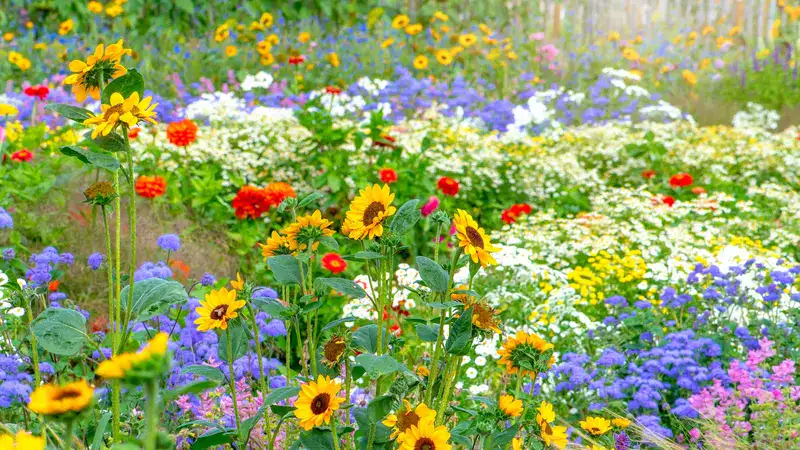Imagine transforming your lawn into a vibrant, eco-friendly habitat that supports pollinators, wildlife, and biodiversity all while reducing maintenance. In the UK, over 97% of traditional wildflower meadow has disappeared since the 1930s, resulting in severe habitat loss for many species. Alongside this, the insect population has plummeted, with an estimated 60% decline in the last 20 years. Additionally, around 30% of bee species are now at risk of extinction, and bird species dependent on meadow habitats have seen population drops of up to 50% in recent decades. Restoring these meadows has never been more crucial, offering a lifeline for biodiversity in a rapidly changing environment.
Below, we explore how to create and maintain a wildflower meadow, the key advantages of this natural landscape, and some practical guidance on overcoming common obstacles.
Why Consider a Wildflower Meadow?
Wildflower meadows serve as habitats for diverse wildlife, which has dwindled due to urban development, monoculture farming, and pesticide use. In the UK, wildflower meadows have declined by more than 97% since the 1930s, drastically impacting pollinators and other native species. Creating a wildflower meadow can play a small but meaningful role in reversing this trend.
These meadows are rich with native wildflowers that attract bees, butterflies, beetles, and other insects essential for pollination. The increased presence of insects in wildflower meadows also creates a robust food chain that benefits birds, bats, and small mammals, fostering a healthier ecosystem. For a homeowner, establishing a meadow is a beautiful way to make a significant impact on local biodiversity.
Types of Wildflower Meadows
1. Traditional Perennial Meadows
- Traditional wildflower meadows consist of perennial wildflowers and grasses, which are cut for hay in late summer and then grazed by animals like cows or sheep until early spring. This cyclical cutting and grazing prevent competitive grasses from overtaking wildflowers, while also allowing perennial flowers to establish dominance in the meadow.
- In a garden, perennial meadows can be created by planting wildflower seeds or plugs alongside perennial grasses. These flowers, including red and white clover, ox-eye daisy, cowslip, and greater knapweed, come back each year with minimal need for replanting, making them relatively low-maintenance.
2. Annual Meadows
- Annual meadows typically contain flowers that bloom, seed and die within a single growing season. These include cornflowers, poppies, and corn marigolds, along with non-native species like cosmos or Mexican hats. Although annual meadows are visually stunning, they are less biodiverse than perennial meadows, as they lack grasses that caterpillars and moth larvae depend on.
- Annual meadows may require re-seeding each year to maintain their vibrant display, making them a higher-maintenance option if you wish to preserve the look season after season.
Advantages of Wildflower Meadows
Creating a wildflower meadow can offer several unique advantages compared to traditional lawns:
- Reduced Maintenance: Once established, wildflower meadows generally require less mowing, fertilizing, and watering than traditional lawns. They naturally control their own growth patterns, particularly with the addition of semi-parasitic plants like yellow rattle, which limits the dominance of grasses.
- Enhanced Biodiversity: A meadow creates an inviting environment for pollinators and small wildlife. In turn, this supports larger species, creating a balanced ecosystem.
- Aesthetic Appeal: Wildflower meadows bring natural beauty and seasonal interest to a landscape, with varied blooms and colorful textures that change throughout the year.
- Eco-Friendly Choice: By reducing the need for frequent mowing and fertilizers, wildflower meadows decrease the environmental footprint of lawn maintenance.
Challenges of Wildflower Meadows
Though wildflower meadows offer numerous advantages, they also come with unique challenges. Here are a few considerations:
- Establishing a Meadow Takes Time: Wildflower meadows don’t appear overnight. The process can take one or two growing seasons for the meadow to reach its full potential, requiring patience and an understanding of plant succession.
- Annual Meadows vs. Perennial Meadows: Annual meadows demand re-seeding each season, while perennial meadows can be more sustainable in the long run. Choosing between these types of meadows depends on how much maintenance you’re willing to commit to.
- Meadows May Look Untidy in Certain Seasons: Unlike well-manicured lawns, meadows go through natural phases of growth, blooming, and drying. By late summer, some may appear patchy or brown as plants go to seed, which can look unkempt to those accustomed to green lawns.
- Potential Fire Risks in Dry Areas: The accumulation of dry, dead plant material in a meadow can pose a fire hazard, especially in regions with hot, dry summers. In such areas, it’s essential to mow and remove dead plant material to reduce this risk.
- Challenges with Pest and Invasive Species Management: Wildflower meadows can attract unwanted pests or invasive species, requiring occasional weeding or pest management. Also, meadows that lack grasses may attract fewer butterfly and moth species.
Creating Your Wildflower Meadow: Step-by-Step Guide
To start a meadow, it’s helpful to understand the different approaches for planting and managing wildflowers. Here’s a practical guide to establishing a meadow at home.
1. Prepare the Soil
- Remove Lawn Treatments: Begin by discontinuing any fertilizers or other lawn treatments. Over time, this will reduce the fertility of the soil, making it more suitable for wildflowers that thrive in low-nutrient conditions.
- Initial Mowing: Continue mowing the lawn for several months and remove the clippings to gradually lower soil fertility.
2. Choose and Plant Wildflowers
- Direct Seeding vs. Plug Plants: Wildflower meadows can be started from seeds or plug plants. Plug plants are often easier to establish, especially if grasses are present, as they have a head start on seed-grown plants.
- Use Yellow Rattle: This semi-parasitic plant helps control vigorous grass growth, allowing wildflowers to flourish. Planting it among other species can increase meadow diversity and give wildflowers more space.
3. Management and Maintenance
- Mowing the Meadow: Wildflower meadows should be cut from late July to early September. Allow the cuttings to sit on the meadow for a few days to drop seeds before composting the remaining material.
- Create Wildlife Corridors: Consider cutting only parts of the meadow at a time to create “buffer zones” where species like butterflies and moths can continue feeding and reproducing.
- Seasonal Upkeep: Meadows can be kept short during winter by mowing or grazing (if animals are available). This mimics natural hay meadows, where grazing animals keep plants in check until spring growth begins.
Wildflower Meadows vs. Traditional Lawns: Making the Choice
1. Maintenance Needs
Traditional lawns require frequent mowing, watering, and fertilizing to stay green and uniform. In contrast, wildflower meadows, once established, only require occasional mowing and minimal watering, making them more sustainable.
2. Aesthetic Considerations
Lawns offer a neat and uniform appearance throughout the year, while meadows provide a wild, ever-changing display. Though meadows may look patchy in off-seasons, they deliver vibrant, natural beauty during peak blooming months.
3. Environmental Impact
Wildflower meadows benefit biodiversity, while lawns are mostly neutral or even detrimental if synthetic chemicals are used for upkeep. Meadows promote native plant growth, attract pollinators, and serve as wildlife habitats, making them more eco-friendly than traditional lawns.
Final Thoughts: Deciding If a Wildflower Meadow Is Right for You
Creating a wildflower meadow uniquely supports local wildlife, improves biodiversity, and introduces low-maintenance beauty to your landscape. The advantages and challenges of wildflower meadows are worth considering before transforming a lawn. They require an initial investment of time and resources but pay off by fostering a healthy ecosystem for various species. For those seeking a meaningful way to contribute to the environment and enjoy a natural, seasonal landscape, wildflower meadows are an ideal choice.

